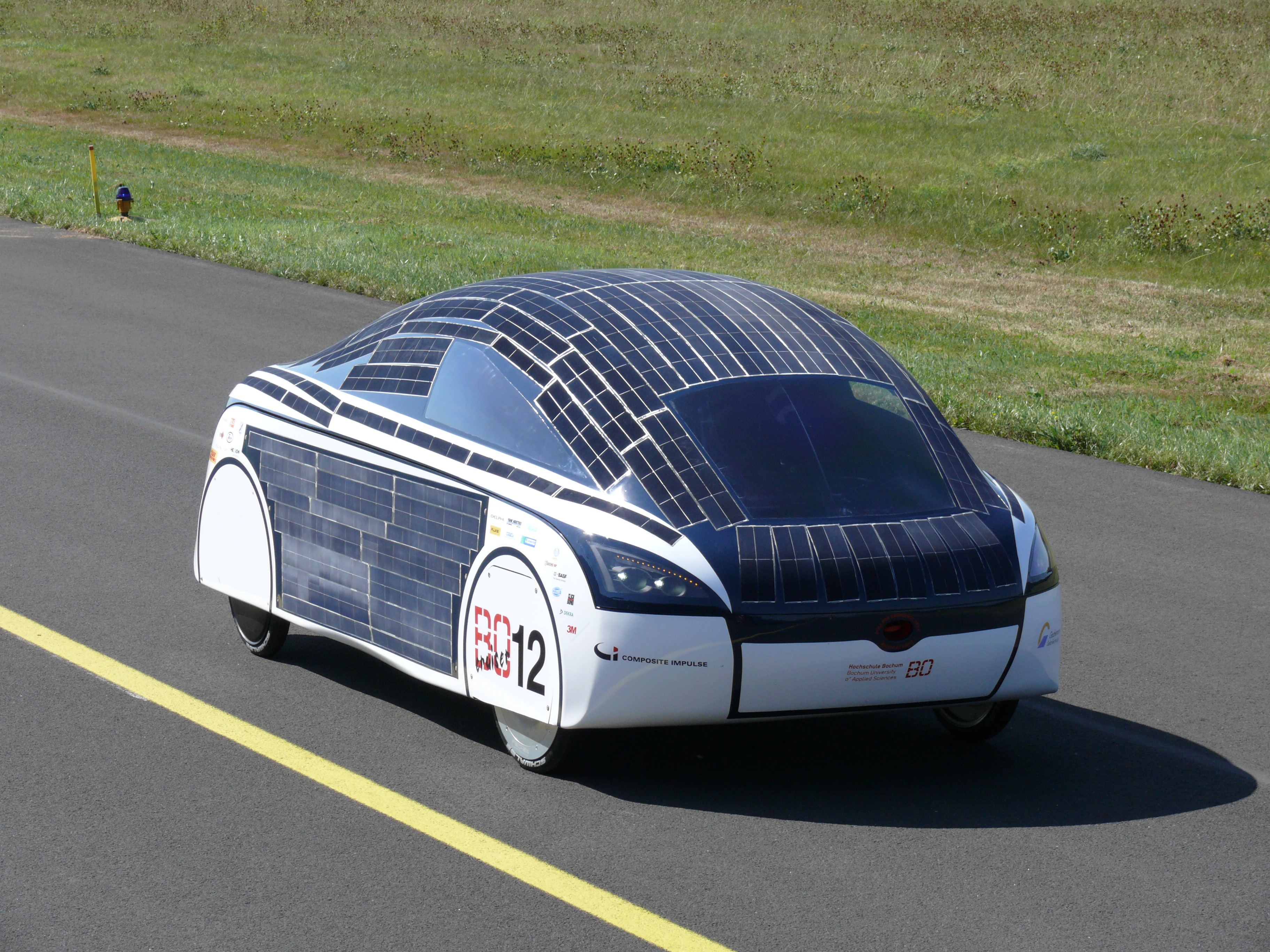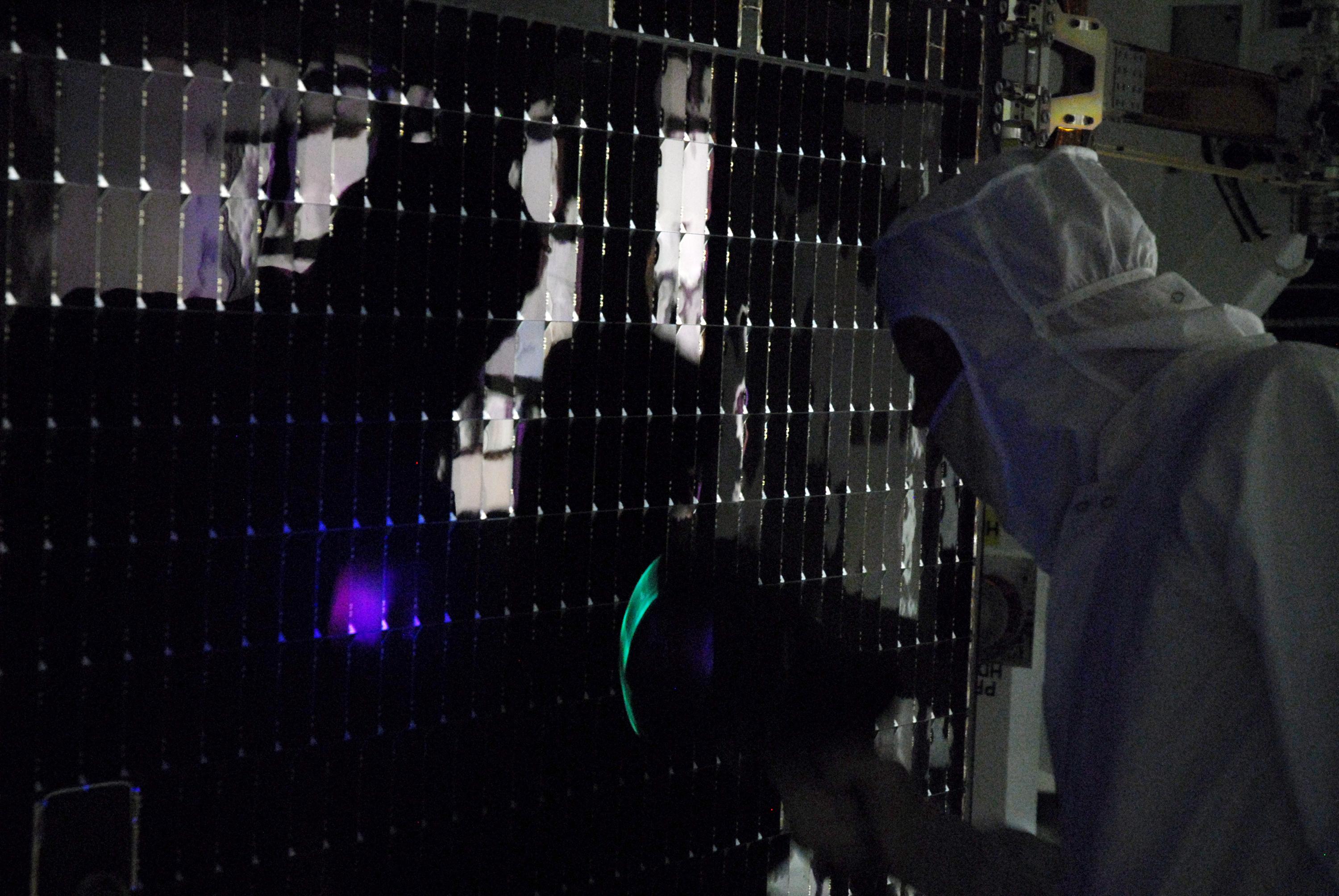|
PowerCore SunCruiser
The PowerCore SunCruiser is a solar-powered road vehicle. It was created at the Ruhr University Bochum, Bochum University of Applied Sciences to compete at the World Solar Challenge in 2013. The PowerCore SunCruiser is the fifth vehicle built by the University of Bochum and categorized as an EC vehicle class L7e, which includes full road approval. The car was presented to the public on 25 July 2013. It offers space for three persons, can reach a top speed of over 100 km/h, and is driven by two wheel-hub motors in the back wheels. Its maximum power is 8.5 kW. The vehicle's empty weight is around 340 kg, of which the batteries take around 63 kg. The range on a fully charged battery in the absence of sunlight is 700 km when driven at a uniform speed of 65 km/h. Its multi-layer solar cells operate at 29.7% efficiency. The performance of the 3 square meter solar cells on the roof is 833 W. Batteries The accumulators make use of 1316 Panasonic NCR 18650B ... [...More Info...] [...Related Items...] OR: [Wikipedia] [Google] [Baidu] |
Ruhr University Bochum
The Ruhr University Bochum (, ) is a public research university located in the southern hills of the central Ruhr area, Bochum, Germany. It was founded in 1962 as the first new public university in Germany after World War II. Instruction began in 1965. The Ruhr-University Bochum is one of the largest universities in Germany and part of the Deutsche Forschungsgemeinschaft, the most important German research funding organization. The RUB was very successful in the Excellence Initiative of the German Federal and State Governments (2007), a competition between Germany's most prestigious universities. It was one of the few institutions left competing for the title of an "elite university", but did not succeed in the last round of the competition. There are currently nine universities in Germany that hold this title. The University of Bochum was one of the first universities in Germany to introduce international bachelor's and master's degrees, which replaced the traditional German Di ... [...More Info...] [...Related Items...] OR: [Wikipedia] [Google] [Baidu] |
Tandem Solar Cell
Multi-junction (MJ) solar cells are solar cells with multiple p–n junctions made of different semiconductor materials. Each material's p-n junction will produce electric current in response to different wavelengths of light. The use of multiple semiconducting materials allows the absorbance of a broader range of wavelengths, improving the cell's sunlight to electrical energy conversion efficiency. Traditional single-junction cells have a maximum theoretical efficiency of 33.16%. Theoretically, an infinite number of junctions would have a limiting efficiency of 86.8% under highly concentrated sunlight. As of 2008 the best lab examples of traditional crystalline silicon (c-Si) solar cells had efficiencies between 20% and 25%, while lab examples of multi-junction cells have demonstrated performance over 46% under concentrated sunlight. Commercial examples of tandem cells are widely available at 30% under one-sun illumination, and improve to around 40% under concentrated sunlight ... [...More Info...] [...Related Items...] OR: [Wikipedia] [Google] [Baidu] |
Gallium Arsenide
Gallium arsenide (GaAs) is a III-V direct band gap semiconductor with a Zincblende (crystal structure), zinc blende crystal structure. Gallium arsenide is used in the manufacture of devices such as microwave frequency integrated circuits, monolithic microwave integrated circuits, infrared light-emitting diodes, laser diodes, solar cells and optical windows. GaAs is often used as a substrate material for the epitaxial growth of other III-V semiconductors, including indium gallium arsenide, aluminum gallium arsenide and others. Preparation and chemistry In the compound, gallium has a +3 oxidation state. Gallium arsenide single crystals can be prepared by three industrial processes: * The vertical gradient freeze (VGF) process. * Crystal growth using a horizontal zone furnace in the Bridgman-Stockbarger technique, in which gallium and arsenic vapors react, and free molecules deposit on a seed crystal at the cooler end of the furnace. * Liquid encapsulated Czochralski process, Czoch ... [...More Info...] [...Related Items...] OR: [Wikipedia] [Google] [Baidu] |
Solar Cell Efficiency
Solar-cell efficiency refers to the portion of energy in the form of sunlight that can be converted via photovoltaics into electricity by the solar cell. The efficiency of the solar cells used in a photovoltaic system, in combination with latitude and climate, determines the annual energy output of the system. For example, a solar panel with 20% efficiency and an area of 1 m2 will produce 200 kWh/yr at Standard Test Conditions if exposed to the Standard Test Condition solar irradiance value of 1000 W/m2 for 2.74 hours a day. Usually solar panels are exposed to sunlight for longer than this in a given day, but the solar irradiance is less than 1000 W/m2 for most of the day. A solar panel can produce more when the sun is high in the sky and will produce less in cloudy conditions or when the sun is low in the sky, usually the sun is lower in the sky in the winter. Two location dependant factors that affect solar PV efficiency are the dispersion and intensity ... [...More Info...] [...Related Items...] OR: [Wikipedia] [Google] [Baidu] |
MPPT
Maximum power point tracking (MPPT) or sometimes just power point tracking (PPT), is a technique used with variable power sources to maximize energy extraction as conditions vary. The technique is most commonly used with photovoltaic (PV) solar systems, but can also be used with wind turbines, optical power transmission and thermophotovoltaics. PV solar systems have varying relationships to inverter systems, external grids, battery banks, and other electrical loads. The central problem addressed by MPPT is that the efficiency of power transfer from the solar cell depends on the amount of available sunlight, shading, solar panel temperature and the load's electrical characteristics. As these conditions vary, the load characteristic ( impedance) that gives the highest power transfer changes. The system is optimized when the load characteristic changes to keep power transfer at highest efficiency. This optimal load characteristic is called the ''maximum power point'' (MPP). MPPT is ... [...More Info...] [...Related Items...] OR: [Wikipedia] [Google] [Baidu] |
List Of Prototype Solar-powered Cars
This list of prototype solar-powered cars comprises multiperson, relatively practical vehicles powered completely or significantly by solar cells ( panels or arrays, mounted on the vehicle) which convert sunlight into electricity to drive electric motors while the vehicle is in motion and have a homologation for public streets. Australia Sunswift V (eVe) The Sunswift V (aka "eVe") from the University of New South Wales was built for the 2013 & 2015 World Solar Challenge. Solar Spirit 3 The "Solar Spirit 3" with 3 seats was built by TAFE South Australia for the 2011 World Solar Challenge. Brazil e.coTech Solar version The "e.coTech" is a normal electric car developed by "HiTech Electric" and is sold only to small and medium-sized businesses. In 2017, the solar version of "e.coTech" was announced and presented to the public in 2018. Canada Schulich Delta The "Schulich Delta" from the University of Calgary was built for the 2013 World Solar Challenge. China ... [...More Info...] [...Related Items...] OR: [Wikipedia] [Google] [Baidu] |
MacCready Solar Challenger
The Solar Challenger was a solar-powered electric aircraft designed by Paul MacCready's AeroVironment. The aircraft was designed as an improvement on the Gossamer Penguin, which in turn was a solar-powered variant of the human-powered Gossamer Albatross. It was powered entirely by the photovoltaic cells on its wing and stabilizer, without even reserve batteries, and was the first such craft capable of long-distance flight. In 1981, it successfully completed a 163-mile (262 km) demonstration flight from France to England. History The Solar Challenger was designed by a team led by Paul MacCready as a more airworthy improvement on the Gossamer Penguin, directly incorporating lessons learned from flight testing the earlier aircraft.Solar Challenger - E ... [...More Info...] [...Related Items...] OR: [Wikipedia] [Google] [Baidu] |
European Championship (auto Racing)
The European Drivers' Championship was an annual competition in auto racing that existed prior to the establishment of the Formula One world championship in 1950. It was established in 1931 Grand Prix season, 1931 and ran until the end of 1939 Grand Prix season, 1939 with a hiatus from 1933–34, and awarded points to drivers based on the results of selected Grand Prix motor racing, Grand Prix races, the so-called ''Grandes Épreuves'' (this term had been used for the most prestigious races since the 1920s; the only ''Grande Épreuve'' to be excluded from the championship was the 1931 German Grand Prix). The championship was discontinued because of the outbreak of World War II in 1939, and no champion was officially declared for the last season. The championship was run by the Association Internationale des Automobile Clubs Reconnus (AIACR), the forerunner to the Fédération Internationale de l'Automobile, FIA who are today's world governing body of motorsport. History The 1931 ... [...More Info...] [...Related Items...] OR: [Wikipedia] [Google] [Baidu] |





